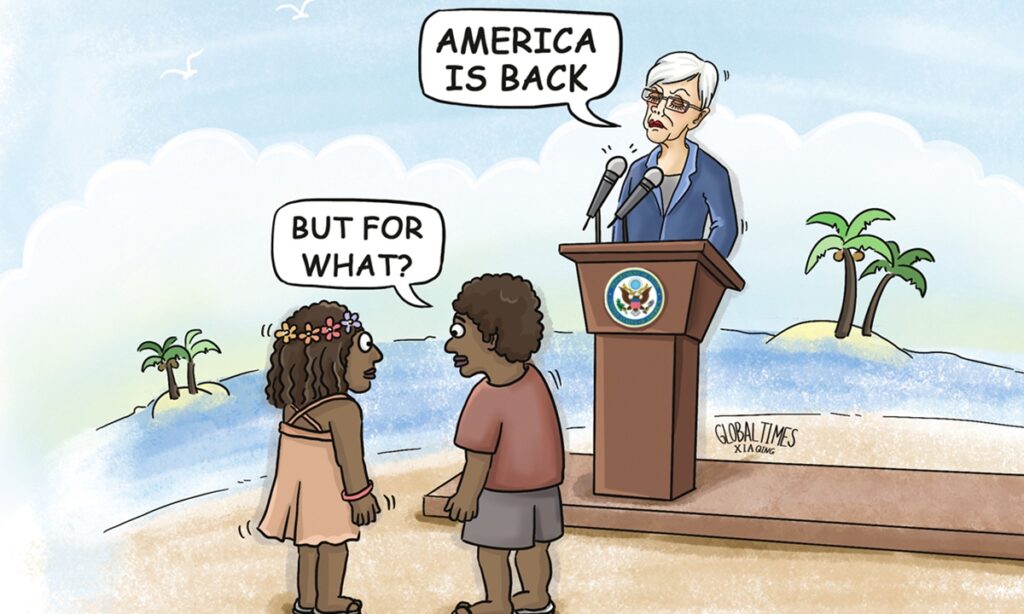The first US-Pacific Island Country Summit was held in Washington on September 28 and 29 with leaders and representatives from 14 Pacific Island countries taking part in it. This is the first time that Pacific Island countries have received an invitation from Washington collectively. The US has carried out high-profile propaganda, repeatedly hyping the summit as a “milestone.” However, public opinion generally believes that this is an “unprecedented diplomatic effort” made by the US to counter China, while at the same time, some island countries are already worried about being forced to take sides.
Washington exaggerated the significance of this summit. This is a new move of a series of actions taken by the US to win over the region since last year after Washington began to take the friendly exchanges between China and the Pacific Island countries as a thorn. According to Kurt Campbell, coordinator for Indo-Pacific Affairs of the National Security Council, “the purpose [of the summit] is not just to listen to Pacific leaders, but to put tremendous resources on the table.” At the summit, US President Joe Biden announced $810 million in new funding for Pacific Island countries to “meet priorities.”
It’s a good thing if Washington can really deliver on its promises. But based on past experiences, the US has too low international reputation for honoring commitments. What’s more worthy of vigilance is that various political conditions have always been attached to the US aid commitments. It’s known to all that the US’ sudden attention paid to the Pacific Island countries is not out of conscience. The US has its own strategic purpose. In recent years, the rapid development of mutually beneficial cooperation between China and Pacific Island countries has become a thorn in the side of the US and it’s eager to remove it.
In other words, getting assistance from the US is always at the expense of a country’s dignity and part of its sovereignty. On the eve of the summit, a think tank funded by the US Congress released a report. It said the Pacific Islands “are an important strategic buffer between US defense assets in Guam and Hawaii and East Asian littoral waters.” According to the report, if Beijing were to “succeed in bringing one of these states into its sphere, it would imperil US military capabilities in a strategically vital geographic command area.” The US wants to make Pacific Island countries be deeply grateful for its “kindness,” bow to it and serve as pawns in its Indo-Pacific Strategy by offering them petty favors, which is the greatest disrespect for the Pacific Island countries.
Perhaps, in Washington’s view, the “privilege” of “getting invited to the White House for the first time,” the reception involving the red carpet and limelight, and “big dollar” aid are enough to make the Pacific Island countries feel extremely flattered and be obedient to the US. But Pacific Island nations enjoy independence and sovereignty, so they want genuine respect from the US, not letting it use a symbolic one with high-profile ceremonies that practice interventionism or use flamboyant new concepts to revive the model of hegemony based on the subordination of small states.
Similar examples can be found everywhere during the summit. For example, some media revealed that the Pacific Island states deleted a reference to the need for them to “consult with one another closely on security decisions with regional impacts” from a draft of the joint declaration, which was seen as a response to the security agreement signed by China and the Solomon Islands. US Secretary of State Antony Blinken announced Wednesday that the US will provide $4.8 million in funding to support activities like sustainable fisheries. He also said Pacific Island leaders were invited to US Coast Guard headquarters to discuss how to improve maritime domain awareness and combat illegal fishing activities. All of these are said to be for the livelihood of the Pacific Island people, but these moves label China as “a threat to fishery” at the same time. In reality, they are used as a grip to monitor and “smear” China, attempting to undermine normal and legitimate fishery cooperation of Pacific Island countries with other countries. This, in turn, harms the interests of people from Pacific Island countries.
For the Pacific Island countries, their core demand is regional prosperity and stability, as they hope that the US will accept their 2050 Strategy for the Blue Pacific Continent to address climate change and promote sustainable development in the region. At the summit, although Washington claimed to take “urgent action” on issues, including the climate crisis, Pacific Island people have serious concerns, since the US is well-known as a straight F student in terms of addressing climate change. What’s more, Washington’s motives are not pure. The Western media does not hide the fact that the US has made an “unprecedented” effort to rope in Pacific Island countries to “counterbalance China’s influence.”
The US’ attitude toward Pacific Island countries has changed from the long-time neglect for nearly 80 years after World War II to the sudden attention aimed at containing China’s influence. What hasn’t changed is the mindset of treating the region as its “backyard,” and what has continued is its hegemonic logic. Such “pride and prejudice” cannot be covered up by a few new missions, visits by senior officials, and declarations of big dollar aid. It is hoped that the US can truly change the way it views the world and other countries and treat Pacific Island countries with sincere respect and equality. This is not only the proper demeanor that a major power should have, but also the minimum responsibility it should assume for regional peace and stability.
(Global Times)




